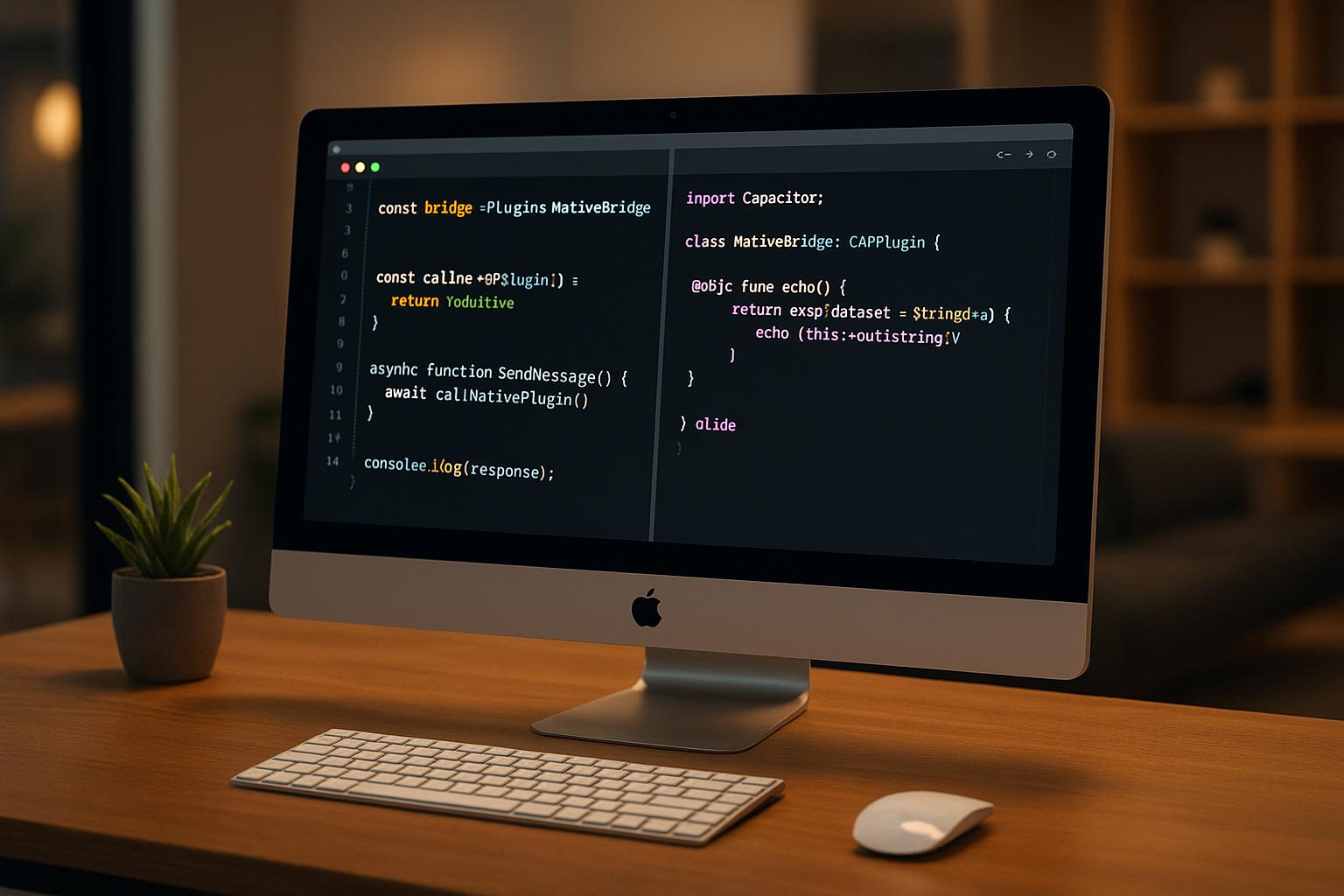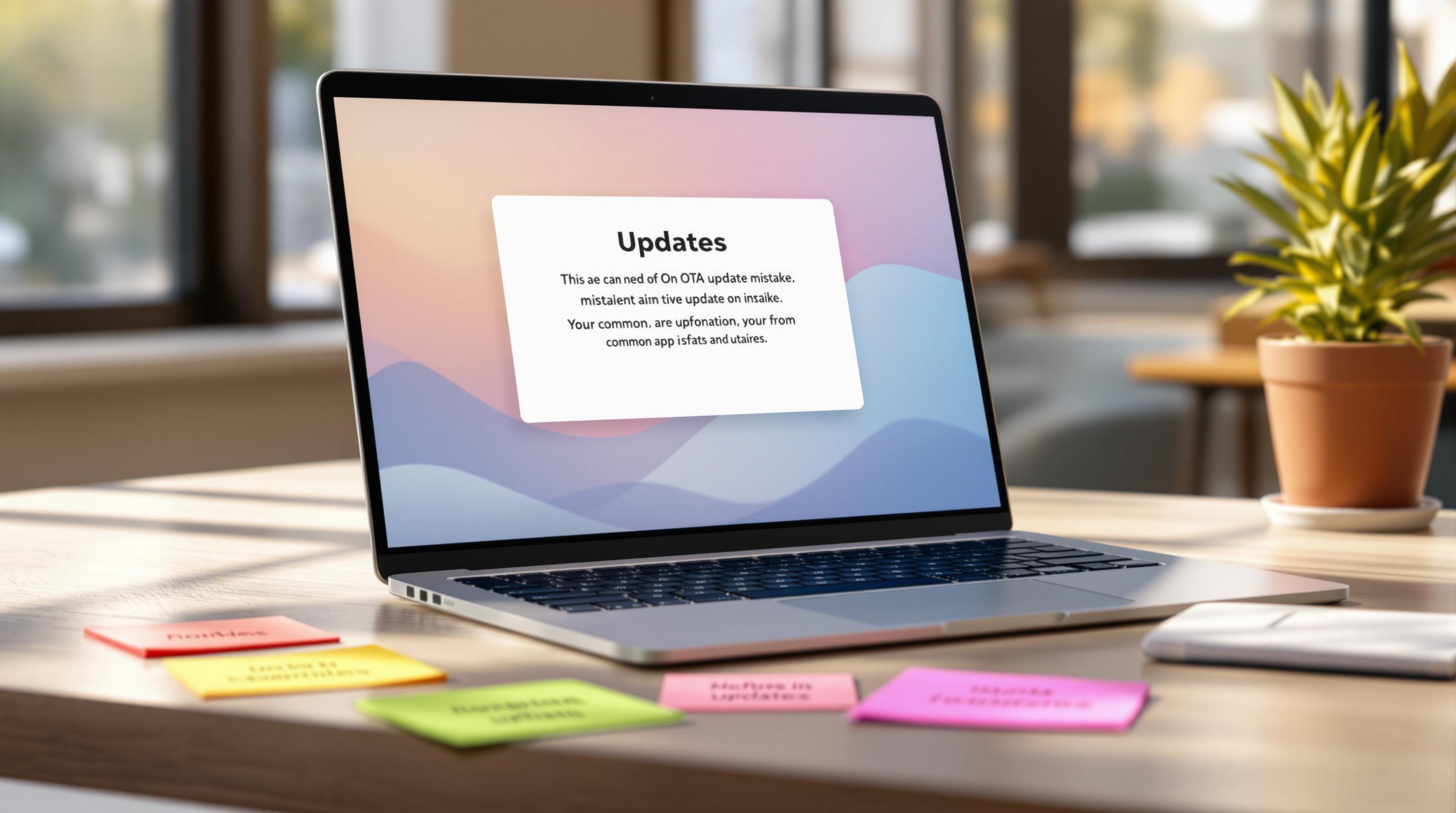A native bridge in Capacitor lets your JavaScript code communicate with iOS-specific features through Swift or Objective-C. Here’s what you need to know:
- What It Does: Enables access to iOS features (e.g., camera, GPS) directly from your web app.
- Requirements: Xcode (v16+), iOS 14+, and knowledge of Swift or Objective-C.
- Steps:
- Install
@capacitor/iosand set up the iOS platform. - Use Xcode to configure your project and add custom plugins.
- Write Swift code to handle communication between JavaScript and native layers.
- Install
- Testing: Run your app on a simulator or device and use detailed logging for debugging.
- Optimization: Focus on error handling, performance (e.g., background threads), and security (e.g., token management).
Capgo can also simplify managing updates for your native bridge without needing app store submissions.
Keep reading for step-by-step instructions, code examples, and best practices!
How to create a Capacitor plugin for iOS/Android
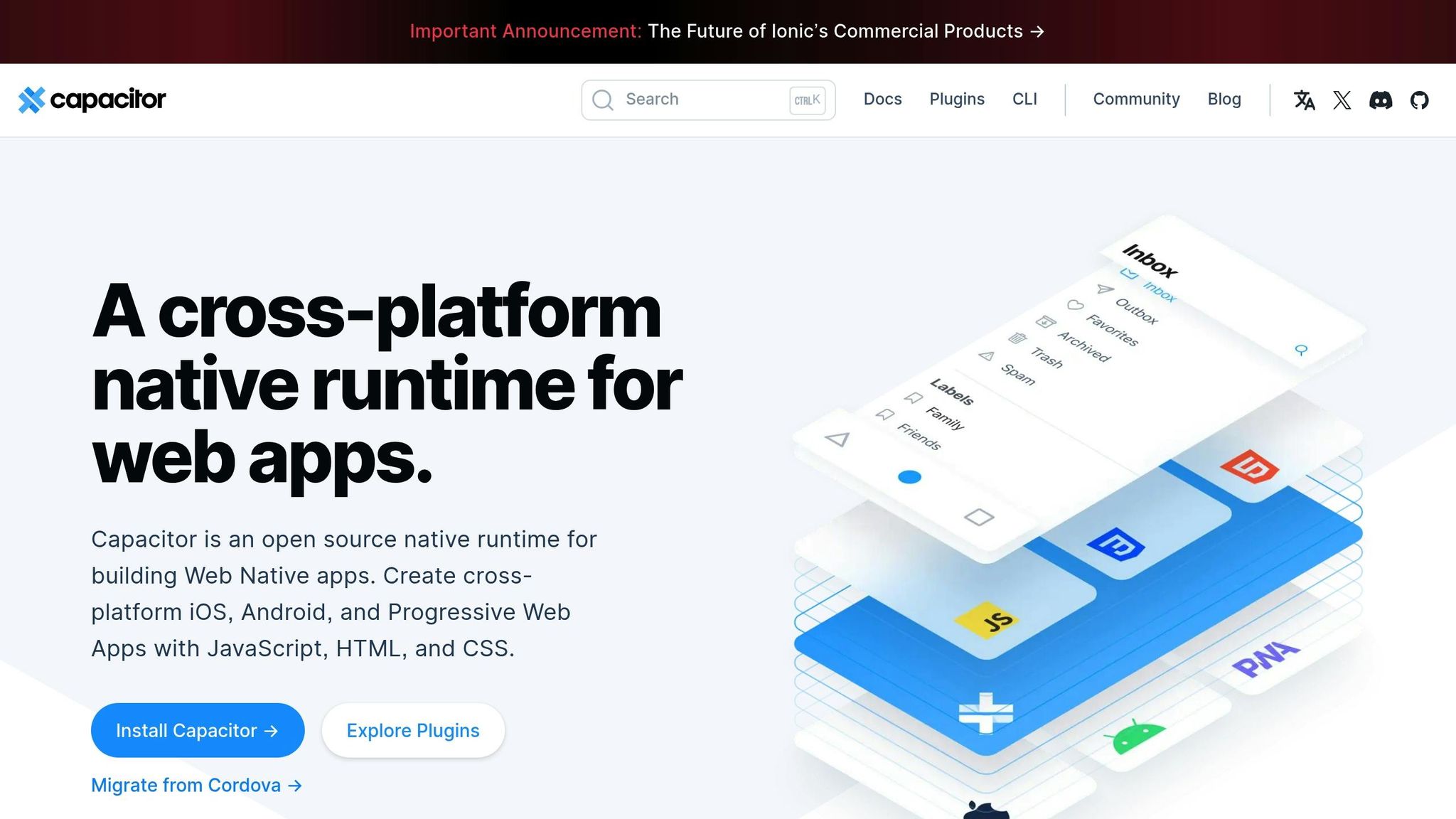
iOS Development Setup
Set up your iOS environment to ensure smooth communication between web and native components in Capacitor.
Adding iOS Support
Start by installing the required Capacitor modules for iOS bridge development:
npm install @capacitor/iosnpx cap add iosThis process initializes the iOS project and installs the necessary dependencies. Capacitor uses WKWebView as the rendering engine, replacing the deprecated UIWebView [1].
Once the setup is complete, open your project in Xcode to continue integrating the native bridge.
Xcode Project Setup
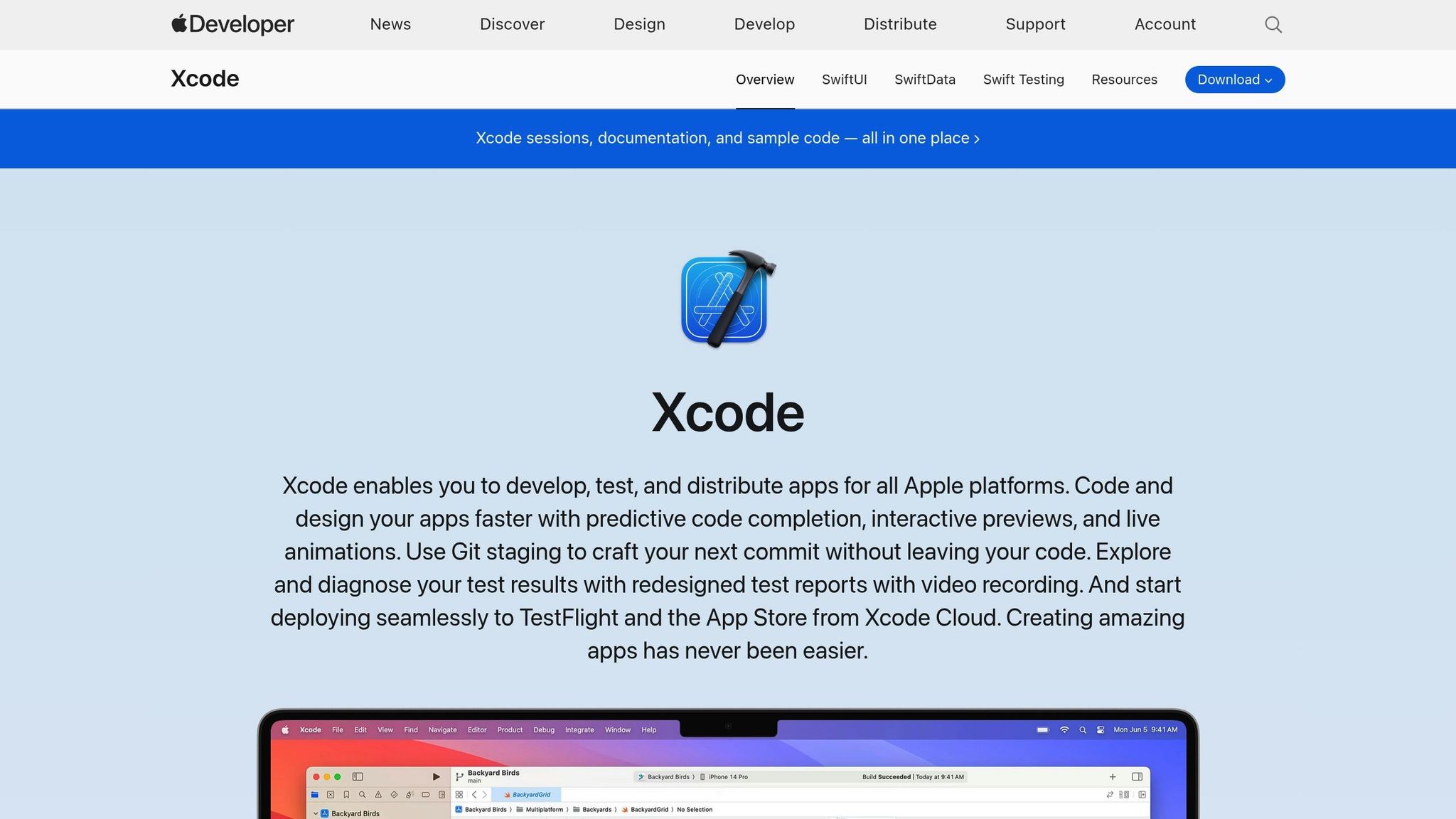
You can open your Xcode project using the command below or manually navigate to the workspace file:
npx cap open iosOr:
open ios/App/App.xcworkspaceAfter opening the project, configure the following settings in Xcode to ensure compatibility:
| Configuration Step | Purpose | Requirement |
|---|---|---|
| iOS Version | Ensure platform support | iOS 14+ |
| Xcode Version | Development environment | 16.0+ |
To add custom plugins, update the MyViewController.swift file with the following code snippet:
override open func capacitorDidLoad() { bridge?.registerPluginInstance(PluginName())}Once these configurations are in place, proceed to test your setup.
Testing Your Setup
Run your app on a simulator or physical device to verify the bridge integration. Enable detailed logging in your Capacitor configuration file to monitor activity:
{ "debugMode": true, "logLevel": "debug"}The Xcode console will display logs for communication between the web and native layers. For instance:
“⚡️ To Native -> ScreenOrientation orientation 115962915⚡️ TO JS {“type”:“portrait-primary”}” [2]
To further debug, use Chrome DevTools or Safari Web Inspector to monitor web-to-native calls.
After making changes to native code, remember to rebuild and sync your project to apply updates:
npm run buildnpx cap sync iosEnsure that the native bridge is functioning correctly within your Capacitor app before moving on to plugin development.
Building a Native Bridge Plugin
Developing a native bridge plugin allows smooth communication between your web application and native functionality.
Plugin Structure Setup
Start by generating a new plugin using Capacitor’s plugin builder. This sets up the necessary file structure for your project:
npm init @capacitor/pluginOnce the plugin is generated, you’ll find essential Swift files included. Open the Package.swift file in Xcode to access and configure these files. Your plugin will require two key Swift classes:
| Class Type | Purpose | Base Class |
|---|---|---|
| Core Plugin Class | Contains core plugin logic | NSObject |
| Bridge | Acts as the JavaScript interface | CAPPlugin & CAPBridgedPlugin |
Swift Implementation
Now, implement the plugin’s functionality in Swift. Use the required decorators and configure the bridge as shown below:
import Capacitor
@objc(MyPlugin)public class MyPlugin: CAPPlugin, CAPBridgedPlugin { public let identifier = "MyPlugin" public let jsName = "MyPlugin"
public let pluginMethods: [CAPPluginMethod] = [ CAPPluginMethod(name: "myMethod", returnType: CAPPluginReturnPromise) ]
@objc func myMethod(_ call: CAPPluginCall) { let inputValue = call.getString("value") ?? "" // Add your implementation logic here call.resolve(["result": inputValue]) }}“A Capacitor plugin for iOS has two simple Swift classes, one is implementation class that extends
NSObject, where you should put the plugin logic and another that extendsCAPPluginandCAPBridgedPluginand has some exported methods that will be callable from JavaScript.” [3]
Plugin Registration
To finalize the integration, register the plugin in Xcode and expose it for JavaScript usage. Add the following code to MyViewController.swift:
override open func capacitorDidLoad() { bridge?.registerPluginInstance(MyPlugin())}Then, expose the plugin in your JavaScript code using Capacitor’s registerPlugin method:
import { registerPlugin } from '@capacitor/core';const MyPlugin = registerPlugin('MyPlugin');export default MyPlugin;While working with your plugin, keep an eye on key performance metrics like bridge call latency, data transfer size, and the success rate of bridge calls. For debugging and testing, refer to the relevant section in your documentation.
With these steps, your plugin is now integrated into the iOS project, enabling efficient communication between the web layer and native Swift methods.
Bridge Development Guidelines
Creating dependable iOS bridges requires careful attention to error management, performance optimization, and security.
Error Management
Effective error handling is essential for maintaining stable communication between web and native layers. Start by validating all incoming data to prevent issues early on:
@objc func processData(_ call: CAPPluginCall) { guard let inputData = call.getString("data") else { call.reject("Missing required data parameter") return }
do { // Process validated data call.resolve(["result": processedData]) } catch { Log.error("Data processing failed", error) call.reject("Processing error", error) }}| Error Level | Action | Purpose |
|---|---|---|
| Input Validation | Type checking, null checks | Prevent invalid data processing |
| Runtime Errors | Try-catch blocks | Handle unexpected failures |
| Bridge Communication | Status monitoring | Track and maintain bridge health |
By addressing errors at these levels, you can ensure smoother operations and focus on enhancing speed and responsiveness.
Speed Optimization
Performance is another key factor. To keep the app responsive, shift heavy tasks to background threads while keeping the main thread free for UI updates:
@objc func heavyOperation(_ call: CAPPluginCall) { DispatchQueue.global(qos: .userInitiated).async { // Perform intensive operation DispatchQueue.main.async { call.resolve(["result": result]) } }}| Optimization Area | Strategy | Performance Impact |
|---|---|---|
| Data Transfer | Batch processing | Reduces the number of bridge calls |
| Thread Management | Background processing | Keeps the UI smooth and responsive |
| Memory Usage | Use of value types | Minimizes memory overhead |
These strategies reduce latency and improve the overall user experience, making the app feel faster and more efficient.
Security Standards
Security is just as critical as performance. Protecting bridge communication ensures data integrity and shields against vulnerabilities. Key practices include:
- Token Management: Store sensitive data, like authentication tokens, securely on the native side rather than in browser storage [4].
- Communication Security: Enforce strict CORS policies and Content Security Policy (CSP) headers to regulate data flow between the web and native layers [4].
- Zero-Trust Principles: Limit outbound communication and validate all data transfers rigorously [4].
@objc func secureOperation(_ call: CAPPluginCall) { guard let token = KeychainWrapper.standard.string(forKey: "authToken") else { call.reject("Authentication required") return }
// Perform secure operation with validated token}Capgo Integration
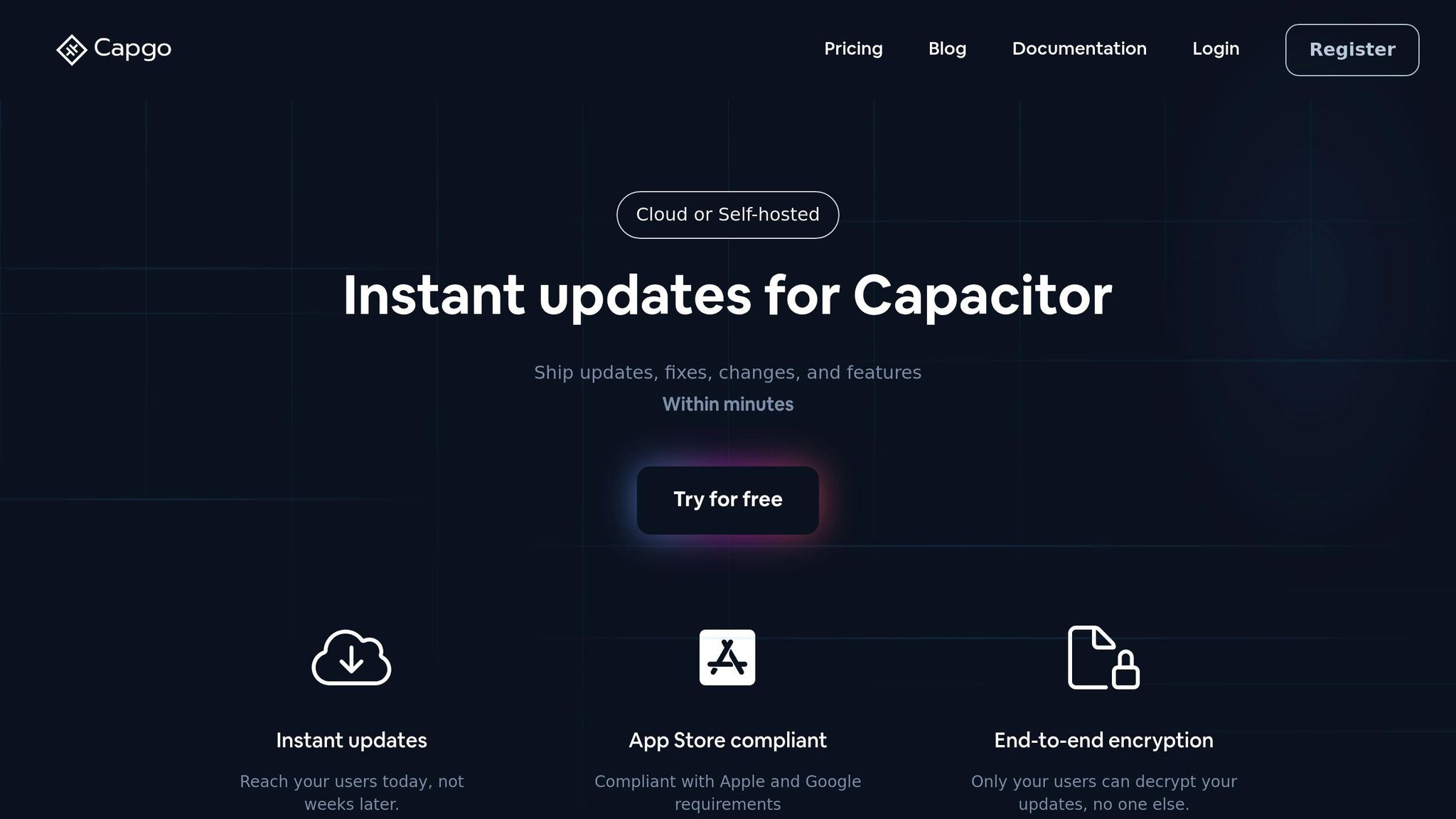
About Capgo
Capgo simplifies live updates for Capacitor apps, especially when it comes to native bridge updates. It allows you to deploy changes to bridge code instantly, skipping the need for app store submissions while staying fully compliant with Apple’s policies.
| Feature | Benefit |
|---|---|
| End-to-End Encryption | Ensures secure update delivery |
| CI/CD Integration | Enables automated deployments |
| Version Control | Simplifies update management |
| Rollback Capability | Reduces risks with easy reversals |
This efficient process extends to native bridges, as explained below.
Capgo and Native Bridges
Capgo streamlines native bridge updates, ensuring they are seamless and compliant with app store regulations. It takes care of versioning and deployment complexities, making updates across your user base much simpler.
Here’s an example of how to implement a Capgo bridge update:
// Example of Capgo bridge update implementation@objc func checkForUpdates(_ call: CAPPluginCall) { CapacitorUpdater.shared.checkForUpdate { result in switch result { case .success(let update): call.resolve([ "version": update.version, "bundleId": update.bundleId ]) case .failure(let error): call.reject("Update check failed", error) } }}Once you’ve set up the code, you can configure Capgo to manage these updates effectively.
Capgo Setup Guide
To use Capgo for managing native bridge updates, you’ll need to configure it properly for reliable performance. Here’s a sample configuration:
{ "plugins": { "CapacitorUpdater": { "autoUpdate": false, "updateUrl": "https://api.capgo.app/updates", "statsUrl": "https://api.capgo.app/stats" } }}To ensure secure and efficient updates, follow these best practices:
- Test bridge functionality in staging: Always validate updates in a controlled environment before deploying them to users.
- Roll out critical changes in phases: Use phased deployments to minimize risks.
- Maintain strict version control: Keep track of all changes for better management and rollback if needed.
A great example of Capgo’s capabilities is Rapido Cloud, which successfully integrated the platform in September 2024. This integration highlighted Capgo’s ability to handle complex native bridge updates while ensuring app stability [5].
| Update Type | Deployment Strategy | Validation Steps |
|---|---|---|
| Minor Changes | Immediate rollout | Basic functionality tests |
| Major Updates | Phased deployment | Comprehensive testing |
| Critical Fixes | Targeted release | Emergency validation |
Capgo offers flexible pricing to suit different development needs. Plans start at $12/month for independent developers and go up to $249/month for enterprises, offering custom features and dedicated support.
Summary
Let’s recap the key points for setting up a native bridge on iOS, as outlined earlier.
Implementing a native bridge in Capacitor requires careful configuration and ongoing upkeep. At its core, the process involves integrating Swift code with @objc decorators, allowing seamless communication between JavaScript and native iOS functionality.
Here are some critical aspects to keep in mind:
- Well-structured plugin design: A solid architecture ensures scalability and maintainability.
- Effective error handling: Address potential issues to ensure a smooth user experience.
- Data security: Use end-to-end encryption and signed updates to protect sensitive information.
Learning Resources
If you’re eager to deepen your understanding of native bridge implementation, there are plenty of helpful resources available:
“Capacitor is essentially a web view - if a component works in the mobile web browser it will work in Capacitor, of course with the addition of being able to access all native features on the device with Capacitor plugin bridge.” - khromov [6]
The Capacitor ecosystem provides a range of tools and documentation to support developers:
- Official Documentation: Capacitor’s Custom Native iOS Code guide offers step-by-step instructions [2].
- Community Support: Developer forums are rich with examples and shared experiences.
- Technical Tutorials: In-depth guides on plugin development and native code integration.
Additionally, tools like Capgo can simplify the process of managing updates for native bridges, helping you refine and optimize your implementation over time.
FAQs
::: faq
How can I securely and efficiently implement a native bridge in Capacitor for iOS?
Best Practices for Implementing a Native Bridge in Capacitor for iOS
When building a native bridge in Capacitor for iOS, security and efficiency should be top priorities. Here are some practical steps to help you achieve both:
-
Protect Your Codebase: Use code obfuscation and minification to make it more challenging for attackers to reverse-engineer your app’s code. These techniques can help safeguard sensitive logic and reduce potential vulnerabilities.
-
Validate Data Exchanges: Always validate the data exchanged between the web and native layers. This step is crucial for preventing injection attacks and ensuring that communication between these components remains secure.
-
Leverage Capacitor’s Plugin System: Capacitor’s plugin system is designed to provide a structured and secure way to bridge web and native code. By using this framework, you can minimize risks and maintain a cleaner codebase.
-
Keep Dependencies Updated: Regularly update your dependencies to benefit from the latest security patches and improvements. Staying informed about updates and recommendations from the Capacitor team is equally important.
-
Streamline Updates with Tools Like Capgo: Tools such as Capgo can simplify live updates and app management, all while ensuring compliance with Apple’s guidelines. This can save time and reduce the complexity of maintaining your app.
By following these practices, you can build a native bridge that is both secure and efficient, setting a strong foundation for your Capacitor-based iOS app. :::
::: faq
What are the best practices for testing and debugging a native bridge in iOS with Capacitor?
To test and debug a native bridge in iOS using Capacitor, it’s important to focus on unit testing, integration testing, and using the right tools for the job.
- Unit testing ensures that individual components function correctly. Frameworks like Jasmine or Karma are great choices for this.
- Integration testing checks how the web and native layers interact. Tools like Protractor can simulate user flows to validate this interaction.
For debugging, you’ll rely on Xcode to troubleshoot native components, while tools like Safari Web Inspector or Chrome DevTools are invaluable for working on the web layer. Enabling source maps is a smart move - it lets you debug the original code instead of dealing with confusing, minified versions.
If you’re using live update services like Capgo, you can push fixes and updates instantly, bypassing the usual delays of app store approvals. This can be a game-changer for resolving issues quickly and efficiently. :::
::: faq
How does Capgo enable updates for native bridges in Capacitor apps without requiring app store approval?
Capgo simplifies the process of updating native bridges in Capacitor apps with Over-the-Air (OTA) updates. This feature lets developers deploy changes instantly, bypassing the need for app store submissions. Whether it’s bug fixes, new features, or asset updates, you can deliver them directly to your users in real time.
Setting up Capgo is quick and straightforward. Its comprehensive auto-update system can be up and running in just minutes. Plus, it ensures your app stays current while adhering to both Apple and Android guidelines. :::

